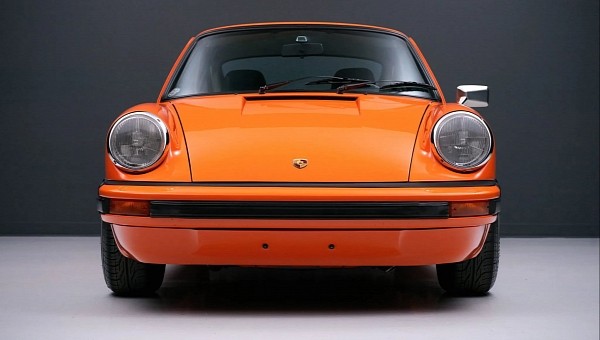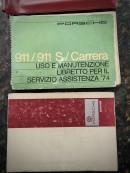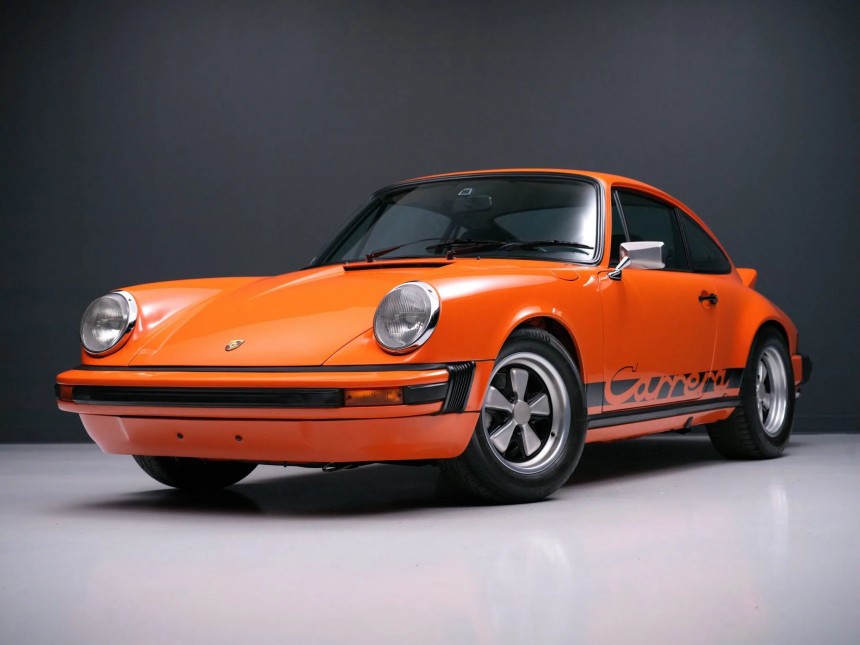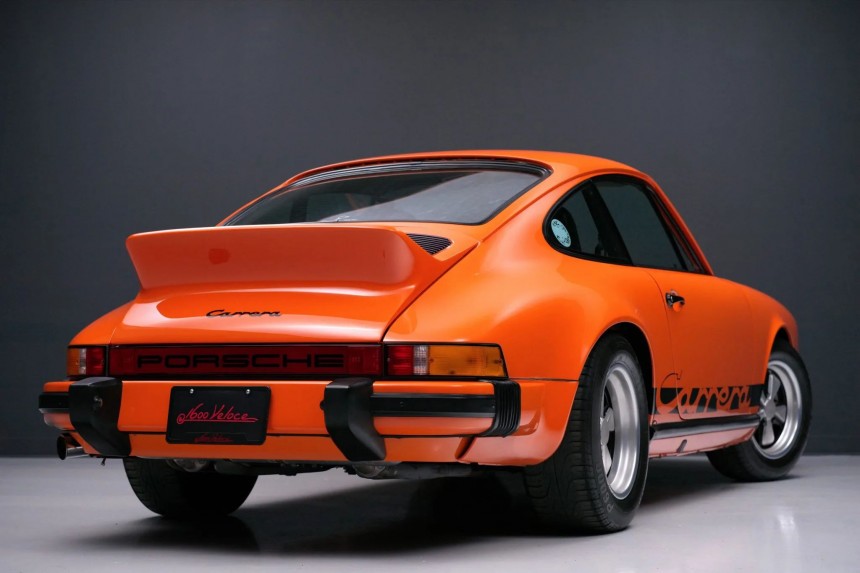The original 911 was a bit long in the tooth when the Neunelfer entered its tenth year in 1973. Tightening emission and safety regulations in the United States forced the Stuttgart-based automaker to redesign the rear-engined sports car inside and out. Produced from August 1973 to July 1974 for model year 1974, the G model started a new era for the 911.
Replacing the 2.4-liter F series, the G model rocks 2.7-liter engines derived from the six-cylinder mill of the 1973 Porsche 911 Carrera RS. Three setups were offered. The most basic specification is referred to as 911/92, the S has the 911/93, and the Carrera packs the 911/83. The 911 replaced the T, and the S replaced the mid-range E in the German sports car’s lineup.
All three setups came standard with Bosch-supplied fuel injection. Running an 8.0:1 compression ratio, the 92 develops 148 horsepower at 5,700 revolutions per minute and 173 pound-feet (235 Nm) of torque at 3,800 revolutions per minute. Featuring an 8.5:1 compression ratio, the 93 levels up to 173 hp at 5,800 rpm and 173 lb-ft, albeit delivered at 4,000 rpm.
As for the crème de la crème, it develops 207 ponies at 6,300 revolutions per minute and 188 pound-foot (255 Nm) at 5,100 revolutions per minute. A homologation special produced in just under 1,500 units, the F-series Carrera RS mentioned earlier flaunts the same figures as the G-model Carrera. Four- and five-speed manuals codenamed 915/16 and 915/06 were offered, with both gearboxes featuring slightly longer ratios than the F series.
Once again, prospective customers could pick a semi-automatic transmission. Developed in collaboration with Fichtel & Sachs, the four-speed unit integrates a vacuum-operated clutch and a torque converter. A microswitch activates the vacuum system through a solenoid when the gear lever is moved by the driver from one position to another.
The torque converter is there to stop the car sans declutching or engaging neutral. The 911 and 911 S equipped with said tranny came with different engine codes compared to their manual counterparts.
Easily distinguishable from the F series by means of body-color bumpers that integrate black rubbing strips and bellows, the G model hides MacPherson struts with single lower wishbones for the front axle.
Out back, semi-trailing arms made from lightweight forged aluminum are used. Tipping the scales at 1,075 kilograms (2,370 pounds) or more, the G model is 4,291 millimeters (168.9 inches) long.
Its wheelbase measures 2,271 millimeters (89.4 inches), and the width ranges from 1,610 to 1,652 millimeters (63.4 to 65 inches). Top speed? According to Porsche, the 911 is good for 210 kilometers per hour (130 miles per hour).
Sporting carryover taillights, the 1974 model year Neunelfer reaches 225 kilometers per hour (140 miles per hour) in S guise. Stepping up to the Carrera sees the top speed increase to 240 kilometers per hour (nearly 150 miles per hour). The 911 and S came with 15- by 5.5-inch steelies, and the Carrera shipped with 15- by 6- and 7-inch Fuchs wheels. The 911 and S could also be specified with 15- by 6-inch cookie cutter-style wheels.
Anti-roll bars of three different widths also need to be highlighted, as well as gas-filled shocks from Bilstein and better-performing brakes for the Carrera. All three G-model versions came with an 80-liter (21.1-gallon) fuel tank designed to accommodate the spare wheel. As far as the Targa is concerned, the removable roof panel can be easily stored in the frunk.
Only 25 kilograms (55 pounds) heavier than the F before it, the G didn’t sell particularly well because of the 1973 oil crisis. The tl;dr version is that OPEC proclaimed an oil embargo in response to America’s support for Israel in the 1973 Yom Kippur War.
As opposed to approximately 13,000 units for the F, the G finished its run in July 1974 with roughly 11,500 units to its name. The most popular configurations were the 911 Coupe (4,014 examples delivered) and 911 Targa (3,110), whereas the rarest configurations were the 911 S Targa (898) and 911 Carrera Targa (433).
In the wake of the energy crisis caused by OPEC’s Arab members, the subsequent H series had few novelties to show for itself. Specifications were unchanged from the 1974 model year, although Porsche – in typical fashion – had to change the engine designations. The 92 became 41, the 93 turned into 42, and the Sportomatic was redesignated 46 and 47 from the prior 97 and 98. The 83 of the manual-only Carrera gladly carried over into 1975.
Emission regulations forced Porsche to drop the 911 from its United States lineup in favor of the S and a detuned version of the Carrera. The range-topping Carrera would be phased out for the 1976 model year in this part of the world in favor of the S and the newly introduced 930 Turbo. The H series also flaunts better sound insulation than its predecessor. The G model’s steel wheels were finally replaced by alloys, and the 1975 model year Carrera also sweetens the deal with body-color headlights surrounds.
Another novelty was the limited-edition 25th Anniversary, produced in 1,063 examples, of which roughly 500 were delivered stateside. Based on either the 911 or 911 S, the 25th Anniversary was finished exclusively in Diamond Silver Metallic. 1975 model year H series production came to a grinding halt in July 1975. A little under 8,000 examples were manufactured.
All three setups came standard with Bosch-supplied fuel injection. Running an 8.0:1 compression ratio, the 92 develops 148 horsepower at 5,700 revolutions per minute and 173 pound-feet (235 Nm) of torque at 3,800 revolutions per minute. Featuring an 8.5:1 compression ratio, the 93 levels up to 173 hp at 5,800 rpm and 173 lb-ft, albeit delivered at 4,000 rpm.
As for the crème de la crème, it develops 207 ponies at 6,300 revolutions per minute and 188 pound-foot (255 Nm) at 5,100 revolutions per minute. A homologation special produced in just under 1,500 units, the F-series Carrera RS mentioned earlier flaunts the same figures as the G-model Carrera. Four- and five-speed manuals codenamed 915/16 and 915/06 were offered, with both gearboxes featuring slightly longer ratios than the F series.
Once again, prospective customers could pick a semi-automatic transmission. Developed in collaboration with Fichtel & Sachs, the four-speed unit integrates a vacuum-operated clutch and a torque converter. A microswitch activates the vacuum system through a solenoid when the gear lever is moved by the driver from one position to another.
The torque converter is there to stop the car sans declutching or engaging neutral. The 911 and 911 S equipped with said tranny came with different engine codes compared to their manual counterparts.
Out back, semi-trailing arms made from lightweight forged aluminum are used. Tipping the scales at 1,075 kilograms (2,370 pounds) or more, the G model is 4,291 millimeters (168.9 inches) long.
Its wheelbase measures 2,271 millimeters (89.4 inches), and the width ranges from 1,610 to 1,652 millimeters (63.4 to 65 inches). Top speed? According to Porsche, the 911 is good for 210 kilometers per hour (130 miles per hour).
Sporting carryover taillights, the 1974 model year Neunelfer reaches 225 kilometers per hour (140 miles per hour) in S guise. Stepping up to the Carrera sees the top speed increase to 240 kilometers per hour (nearly 150 miles per hour). The 911 and S came with 15- by 5.5-inch steelies, and the Carrera shipped with 15- by 6- and 7-inch Fuchs wheels. The 911 and S could also be specified with 15- by 6-inch cookie cutter-style wheels.
Anti-roll bars of three different widths also need to be highlighted, as well as gas-filled shocks from Bilstein and better-performing brakes for the Carrera. All three G-model versions came with an 80-liter (21.1-gallon) fuel tank designed to accommodate the spare wheel. As far as the Targa is concerned, the removable roof panel can be easily stored in the frunk.
As opposed to approximately 13,000 units for the F, the G finished its run in July 1974 with roughly 11,500 units to its name. The most popular configurations were the 911 Coupe (4,014 examples delivered) and 911 Targa (3,110), whereas the rarest configurations were the 911 S Targa (898) and 911 Carrera Targa (433).
In the wake of the energy crisis caused by OPEC’s Arab members, the subsequent H series had few novelties to show for itself. Specifications were unchanged from the 1974 model year, although Porsche – in typical fashion – had to change the engine designations. The 92 became 41, the 93 turned into 42, and the Sportomatic was redesignated 46 and 47 from the prior 97 and 98. The 83 of the manual-only Carrera gladly carried over into 1975.
Emission regulations forced Porsche to drop the 911 from its United States lineup in favor of the S and a detuned version of the Carrera. The range-topping Carrera would be phased out for the 1976 model year in this part of the world in favor of the S and the newly introduced 930 Turbo. The H series also flaunts better sound insulation than its predecessor. The G model’s steel wheels were finally replaced by alloys, and the 1975 model year Carrera also sweetens the deal with body-color headlights surrounds.
Another novelty was the limited-edition 25th Anniversary, produced in 1,063 examples, of which roughly 500 were delivered stateside. Based on either the 911 or 911 S, the 25th Anniversary was finished exclusively in Diamond Silver Metallic. 1975 model year H series production came to a grinding halt in July 1975. A little under 8,000 examples were manufactured.

































